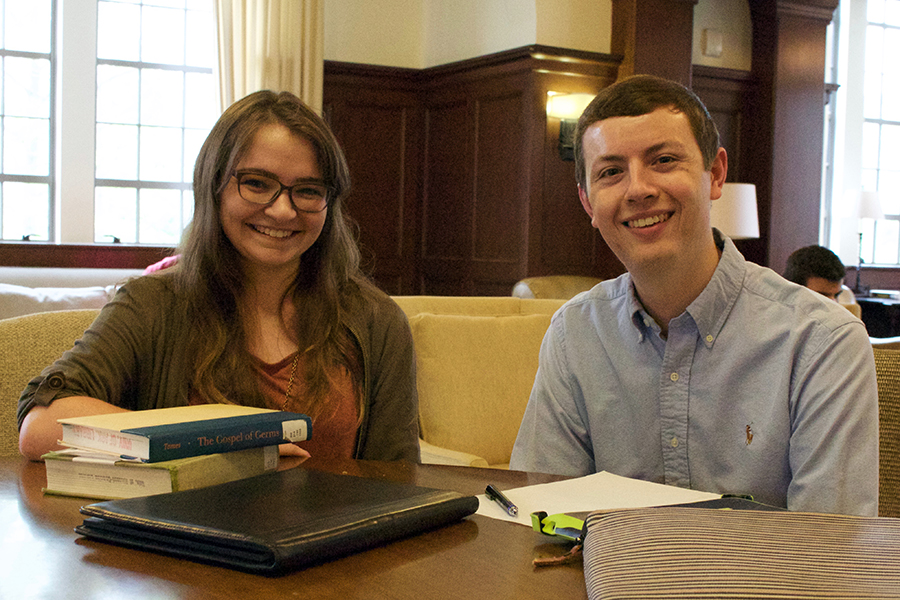
Two Honors College students researching the medical history of Arkansas – a relatively new field of inquiry for historians – have received grants from the University of Arkansas Medical School Library/Society for the History of Medicine and the Health Professions. Caitlin Beasley and Corbin Stinnett are both history majors in the J. William Fulbright College of Arts and Sciences and will receive $1,000 each in support of their research.
Caitlin Beasley, an Honors College Fellow from Owasso, Oklahoma, is completing her honors thesis titled "The Medical Marketing of Eureka Springs, Arkansas" under the direction of Trish Starks, associate professor of history. She studied advertisements promoting Eureka Springs from its glory days in the 1880s, when the town flourished as a medical mecca for invalids, to the early 1900s, when marketing shifted to promote Eureka as a fashionable health resort for the middle class.
"The springs were the linchpin," Beasley said. "People believed that drinking that cold, pure water would get rid of nasty build up - kind of like cleanses today. We haven't really gotten away from that." Newspaper advertisements and lavishly illustrated promotional pamphlets positioned the little town as a cure-all destination. With the advent of germ theory and a more scientific approach to disease in the late 19th century, Beasley found that the town retooled its advertising strategy. Boosters launched the Eureka Springs Medical Journal in 1894 "to promote science and the Springs," and later advertisements stressed that Eureka Springs was in step with the new "scientific medicine," differentiating the town from other alternative medical communities such as Hot Springs. "They had to show that they were not like those other charlatans," Beasley quipped.
She plans to spend this summer researching in the UAMS Historical Research Center in Little Rock, and hopes in particular to find records that indicate how many people traveled to Eureka Springs during this period. "It would be cool to get some numbers," she said. Next fall, she will begin a master's program in the history of science, technology and medicine at the University of Oklahoma. Her research has also been supported by an Honors College Research Grant.
Corbin Stinnett, a junior history major from Siloam Springs, has just embarked on his honors thesis, to be titled "Confronting the Crimson Killer: A Critical Examination of Pellagra Eradication in Arkansas." Pellagra, a disease arising from vitamin deficiency, swept through Arkansas between 1902 and 1945, killing more than 10,000 Arkansans in the first decades of the 20th century.
"It's the 'disease of the three Ds' – dermatitis, diarrhea and dementia – and it was commonly found in individuals on the fringe of society who relied on a diet of corn," Stinnett said. U.S. Public Health Service officials sent to Arkansas to combat the disease described local government and health officials as hostile to their efforts, and their accounts have been widely accepted by historians. Acting on the suggestion of mentor Michael Pierce, associate professor of history, Stinnett examined local accounts.
"The Arkansas officials report agreement with the methods of the national public health officials," Stinnett said. "I found that discrepancy and wanted to look more into that, and see what really went on." He plans to conduct research in state health records and other primary documents held at the UAMS archives. His research has also been supported by a State Undergraduate Research Fellowship.
"I am so proud of these young historians who are breaking new ground," said Honors College Dean Lynda Coon. "The fact that they are delving into primary research as undergraduates attests to their brilliance, and the superlative support they are receiving from their faculty mentors."
Beasley admits that sifting through decades of newspapers on microfilm has not been easy: "You have to identify trends, and note what changed, when, and why. It's definitely been a stretch for me, with lots of skinned knees and toes, but slowly, I'm getting better!"
Contacts
Kendall Curlee, director of communications
Honors College
479-575-2024, kcurlee@uark.edu